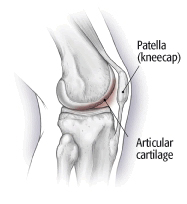 |
Chondromalacia: This term refers to the softening and deterioration of the underside of the kneecap. In athletes, this is typically an injury from trauma, overuse, poor alignment of the knee joint, or muscle imbalance
What are the symptoms of chondromalacia patellae?
Chondromalacia patellae will typically present as pain in the knee region, known as patellofemoral pain. You may feel sensations of grinding or cracking when bending or extending your knee. Pain may worsen after sitting for a prolonged period of time or during activities that apply extreme pressure to your knees, such as standing for an extended period or exercising.
Talk to your doctor if you have knee pain that doesn’t improve within a few days.
Diagnosing and grading chondromalacia patellae
Your doctor will look for areas of swelling or tenderness in your knee. They may also look at how your kneecap aligns with your thigh bone. A misalignment can be an indicator of chondromalacia patellae. Your doctor may also apply resistive pressure to your extended kneecap to determine the tenderness and severity.
Afterward, your doctor may request any of the following tests to aid in diagnosis and grading:
- X-rays to show bone damage or signs of misalignment or arthritis
- magnetic resonance imaging (MRI) to view cartilage wear and tear
- arthroscopic exam, a minimally invasive procedure to visualize the inside of the knee that involves inserting an endoscope and camera into the knee joint
Grading
There are four grades, ranging from grade 1 to 4, that designate the severity of runner’s knee. Grade 1 is least severe, while grade 4 indicates the greatest severity.
- Grade 1 severity indicates softening of the cartilage in the knee area.
- Grade 2 indicates a softening of the cartilage along with abnormal surface characteristics. This usually marks the beginning of tissue erosion.
- Grade 3 shows thinning of cartilage with active deterioration of the tissue.
- Grade 4, the most severe grade, indicates exposure of the bone with a significant portion of cartilage deteriorated. Bone exposure means bone-to-bone rubbing is likely occurring in the knee.
Treatment options for chondromalacia patellae
The goal of treatment is to reduce the pressure on your kneecap and joint. Resting, stabilizing, and icing the joint may be the first line of treatment. The cartilage damage resulting in runner’s knee can often repair itself with rest.
Your doctor may prescribe several weeks of anti-inflammatory medication, such as ibuprofen, to reduce inflammation around the joint. If swelling, tenderness, and pain persist, the following treatment options may be explored.
Physical therapy
Physical therapy focusing on strengthening the quadriceps, hamstrings, adductors, and abductors can help improve your muscle strength and balance. Muscle balance will help prevent knee misalignment.
Typically recommended are non-weight-bearing exercises, such as swimming or riding a stationary bike. Additionally, isometric exercises that involve tightening and releasing your muscles can help to maintain muscle mass.
Consult a trainer or Physiotherapist for further knowledge or guidelines.
Surgery
Arthroscopic surgery may be necessary to examine the joint and determine whether there’s misalignment of the knee. This surgery involves inserting a camera into your joint through a tiny incision. A surgical procedure may fix the problem. One common procedure is a lateral release. This operation involves cutting some of your ligaments to release tension and allow for more movement.
Other surgical options may involve smoothing the back of the kneecap, implanting a cartilage graft, or relocating the insertion of the thigh muscle.


